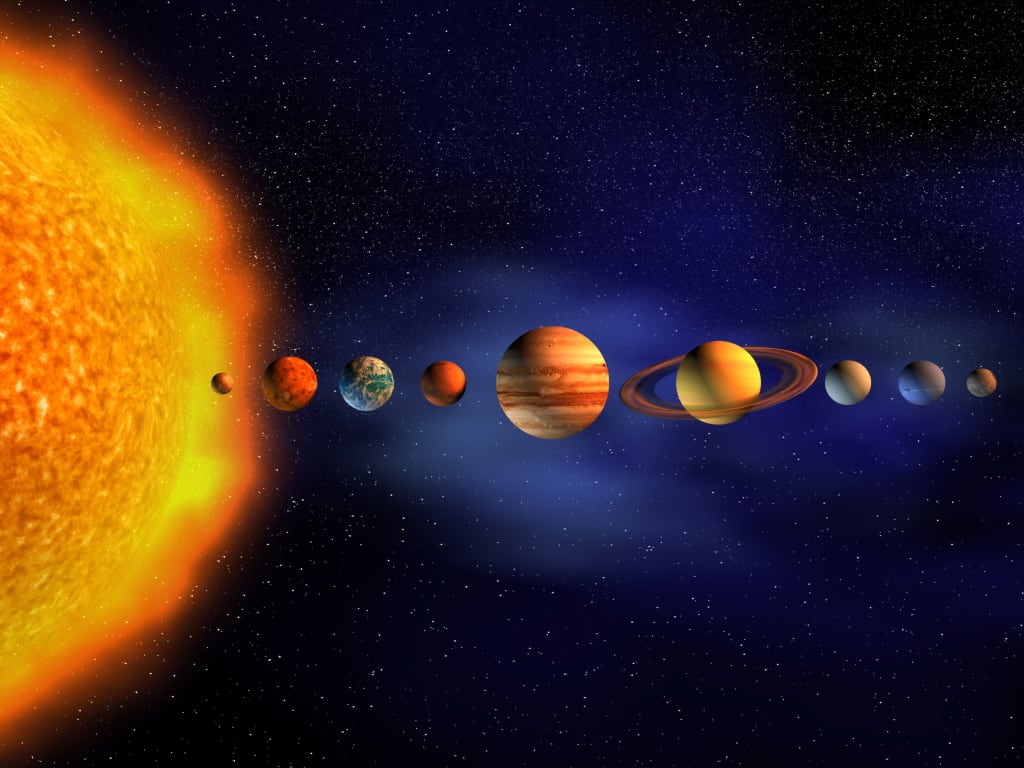
Mercury:
Now that we have a solid understanding of the formation of the universe, the Milky Way, and the solar system, as well as a brief history of how humans have come to comprehend the solar system, we are ready to examine each object in the solar system in detail. We will be moving forward in time from the previous chapter, as significant advancements have been made in astronomy since Newton's era, but we will later revisit and discuss 20th-century discoveries and the current frontiers of the field and their implications. Let's start by looking at the planets one by one as astronomers currently perceive them. The eight planets can be grouped into two sets of four - the inner, terrestrial planets, which are small and rocky, and the outer, gaseous giants.
The first planet, starting from the sun and working outward, is Mercury, the innermost one. It is also the smallest of all the planets, with a radius one-third that of Earth and a mass one-twentieth as much. Mercury is a desolate, gray, and cratered world. Being so close to the sun, with an average orbital distance of just under 60 million kilometers, it has no chance of supporting an atmosphere. This also means that Mercury experiences extreme temperature variations, soaring to a scorching 700 Kelvin (hot enough to melt lead) during the day when facing the sun, and plummeting to a frigid 100 Kelvin (much colder than any place on Earth) at night, with no atmosphere to retain the heat. This makes Mercury one of the most extreme temperature environments in the solar system.
As the closest planet to the sun, Mercury has an orbital period of less than 90 days, making it the fastest-moving object in the solar system. This is why it was named after the Roman messenger god Mercury, who was believed to swiftly deliver messages across the heavens. Our knowledge of Mercury's interior is somewhat speculative, as we have never landed a spacecraft on the planet, but only have data from flybys and orbiting missions, such as Mariner 10 in the 1970s and MESSENGER in the 2000s. These missions have provided valuable images and data, allowing us to infer that Mercury has an iron-nickel core occupying around 55% of its volume, likely in a molten state, which would explain its weak magnetic field (about 1% of Earth's). Mercury also rotates very slowly, completing one rotation every 59 days, resulting in a "solar day" on Mercury that lasts 176 Earth days.
Mercury is considered an "inferior" planet, meaning it orbits closer to the sun than Earth does. This affects its visibility in the sky and makes it quite challenging to observe. However, Mercury holds a special place not only in astronomy but also in theoretical physics. When Newton used Kepler's laws to explain the motion of the planets, there was one anomaly – Mercury's orbit exhibited a slow precession, or shift over time, that did not conform to the predictions as well as the other planets. This perihelion precession was a mystery until the early 20th century, when Einstein's general theory of relativity provided the solution. The warping of spacetime caused by the sun's gravity, which is most pronounced for the closest planet, Mercury, accounted for the observed precession, solving the long-standing problem.
Venus:
The second planet from the sun with an average orbital radius of 108 million kilometers. Venus is often referred to as Earth's "sister planet" due to its similar size and mass. However, the surface conditions on Venus could not be more different from Earth.
Venus has an extremely thick atmosphere composed of 96% carbon dioxide, with the remainder being mostly nitrogen. This high concentration of the greenhouse gas CO2 results in surface temperatures reaching a scorching 863 degrees Fahrenheit - the hottest in the solar system, even hotter than Mercury. The planet is also blanketed in dense clouds of sulfuric acid, making it impossible to see the surface from telescopes.
Early observers knew Venus as either the "evening star" or the "morning star" depending on its position relative to Earth in their orbits. It wasn't until the 1970s that detailed surface features were mapped using radar data, revealing a predominantly flat landscape with two large highland regions named after the Babylonian and Greek goddesses of love.
One of the most unique aspects of Venus is its retrograde rotation, meaning the sun rises in the west and sets in the east. This is believed to be the result of a massive collision during the formation of the solar system.
Earth:
The inner planets of the solar system are rocky worlds known as terrestrial planets, and Earth is the third planet from the sun - our home. Despite the progress towards manned missions to other planets, every human being that has ever existed was born, lived, and died on Earth, never setting foot on any other planet.
We'll discuss the formation of the Earth and its large moon, which is our first encounter with such an object, as Mercury and Venus do not have natural satellites. The early Earth was a largely molten object formed by the accumulation of matter in the protoplanetary disk, with collisions generating heat and shaping the planet. As the Earth cooled, a crust formed, and gases released during this process created the early atmosphere. Comets later delivered more atmosphere and water.
The Earth's composition is well understood, with a core made mainly of iron and nickel, surrounded by a rocky mantle, and a thin crust on the surface. Density determines the distribution of materials, with the heaviest elements at the center and lighter substances towards the surface. The liquid outer core, along with the Earth's rotation, generates a powerful magnetic field that shields us from cosmic radiation.
The Earth has a single moon, believed to have formed from the debris of a collision between the proto-Earth and a Mars-sized object. The moon has a rocky crust, no atmosphere, and its synchronous rotation with the Earth causes tides. These tidal forces may have been crucial for the development of early life on our planet.
From the birth of the universe to the formation of life on Earth, we have now traced the remarkable journey that led to the existence of humans, who can now gaze up at the night sky and comprehend our place in the vast cosmos. This understanding should not make us feel small, but rather empower us as we continue to explore and learn about the universe.
About the Creator
Enjoyed the story? Support the Creator.
Subscribe for free to receive all their stories in your feed. You could also pledge your support or give them a one-off tip, letting them know you appreciate their work.






Comments
There are no comments for this story
Be the first to respond and start the conversation.